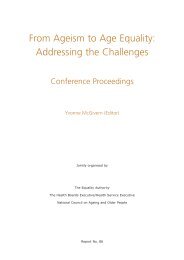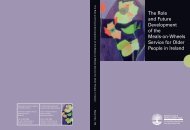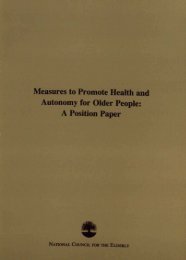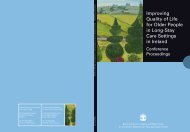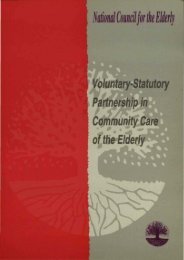Improving Quality of Life for Older People in Long-Stay Care ...
Improving Quality of Life for Older People in Long-Stay Care ...
Improving Quality of Life for Older People in Long-Stay Care ...
- No tags were found...
Create successful ePaper yourself
Turn your PDF publications into a flip-book with our unique Google optimized e-Paper software.
social activities and reta<strong>in</strong><strong>in</strong>g a role <strong>in</strong> society; and hav<strong>in</strong>g enough money to meetbasic needs, participate <strong>in</strong> society, enjoy life and reta<strong>in</strong> one’s <strong>in</strong>dependence andcontrol over life. Many <strong>of</strong> these themes are relevant to people <strong>in</strong> all age categories,while some are particular to people <strong>in</strong> their later years.72However, older people do not comprise a homogeneous group; it is not possible togeneralise about the concept <strong>of</strong> quality <strong>of</strong> life <strong>for</strong> older people, given the variety <strong>of</strong>circumstances <strong>in</strong> which older people may live their lives. <strong>Quality</strong> <strong>of</strong> life will differ<strong>for</strong> able older people and <strong>for</strong> older people who may suffer from a physical or mentaldisability. Old age is <strong>of</strong>ten accompanied by <strong>in</strong>creas<strong>in</strong>g ill-health and decl<strong>in</strong><strong>in</strong>gphysical and mental ability. The goal <strong>of</strong> health <strong>in</strong>terventions <strong>for</strong> older people maybe to m<strong>in</strong>imise the negative affects <strong>of</strong> <strong>in</strong>firmity and improve the person’s quality<strong>of</strong> daily life rather than effect a cure. Some older people are unable to rema<strong>in</strong> <strong>in</strong>their own home due to <strong>in</strong>creased frailty and difficulty cop<strong>in</strong>g with activities <strong>of</strong> dailyliv<strong>in</strong>g, and so require residential care. A further dist<strong>in</strong>ction may, there<strong>for</strong>e, have tobe made between dependent older people who live at home and dependent olderpeople liv<strong>in</strong>g <strong>in</strong> residential care, as quality <strong>of</strong> life doma<strong>in</strong>s may differ between thetwo sett<strong>in</strong>gs. It is important to recognise this heterogeneity when consult<strong>in</strong>g olderpeople about the quality <strong>of</strong> their lives. As Kane (2003c) notes, older people whodo not require long-term care may have different and higher expectations <strong>for</strong> theirquality <strong>of</strong> life than recipients <strong>of</strong> long-term care.A universal quality <strong>of</strong> life measurement <strong>in</strong>strument, the World Health Organisation<strong>Quality</strong> <strong>of</strong> <strong>Life</strong> Survey (WHOQOL-100) has been developed by the World HealthOrganisation (WHO). This <strong>in</strong>strument is applicable to quality <strong>of</strong> life among all age groupsand <strong>in</strong> all sett<strong>in</strong>gs. In order to ascerta<strong>in</strong> the factors that contributed to quality <strong>of</strong> life,the WHO consulted focus groups comprised <strong>of</strong> health pr<strong>of</strong>essionals, and members<strong>of</strong> the general population who were ‘healthy’ and those who were <strong>in</strong> receipt <strong>of</strong> healthservices. Six quality <strong>of</strong> life doma<strong>in</strong>s emerged from the consultation process. Thedoma<strong>in</strong>s ranged from health-related factors such as physical, psychological and level<strong>of</strong> <strong>in</strong>dependence factors, which <strong>in</strong>clude aspects such as pa<strong>in</strong> and discom<strong>for</strong>t, mobilityand self-esteem, to social factors such as social relationships and spirituality. Theenvironment also emerged as an important contributor to quality <strong>of</strong> life. The doma<strong>in</strong>sreflect the multidimensional and all-encompass<strong>in</strong>g nature <strong>of</strong> quality <strong>of</strong> life. Theyalso reflect the difficulty <strong>of</strong> measur<strong>in</strong>g the concept <strong>of</strong> quality <strong>of</strong> life. While it may berelatively easy to observe and measure physical or environmental features, it provesmore difficult to measure self-esteem or the level <strong>of</strong> social support <strong>of</strong> an <strong>in</strong>dividual.An abbreviated version <strong>of</strong> this <strong>in</strong>strument – the WHOQOL-BREF (The WHOQOLGroup, 1998) has also been developed which <strong>in</strong>cludes just four doma<strong>in</strong>s as follows:physical health, psychological health, social relationships and environment.<strong>Improv<strong>in</strong>g</strong> <strong>Quality</strong> <strong>of</strong> <strong>Life</strong> <strong>for</strong> <strong>Older</strong> <strong>People</strong> <strong>in</strong> <strong>Long</strong>-<strong>Stay</strong> <strong>Care</strong> Sett<strong>in</strong>gs <strong>in</strong> Ireland







